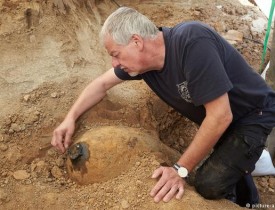AVA- At least 60,000 people were forced to leave their homes in central Frankfurt on Sunday, as Germany begins an operation to defuse a huge unexploded World War II bomb dubbed "blockbuster".
The operation is the biggest evacuation of its kind in post-war Germany, Frankfurt's security chief Markus Frank said.
The 1.8-tonne British bomb, which German media said was nicknamed "Wohnblockknacker" -- or blockbuster -- for its ability to wipe out whole streets and flatten buildings, was discovered on Tuesday during building works.
Police have since been guarding the bomb site, which is close to the city centre and just some 2.5 kilometres (1.5 miles) north of the main Zeil shopping area.
Homes and buildings within a 1.5-kilometre radius of the site were due to be cleared by 0600 GMT, but some people were still in the evacuation zone mid-morning when police carried out door-to-door checks.
At one building where officers were ringing the doorbells and using loudspeakers to announce the evacuation, a man and a woman emerged, saying they were unaware they were in the affected district.
Others had packed their bags and were ready to head out for a full day, as residents are required to stay away until around 1800 GMT.
David Hoffmann, 29, who works at a bank, was putting away his luggage in his car.
"I have the essentials with me -- the most important documents," he said, complaining that he had received no leaflets about the evacuation.
Claudia Schmitt, 61, who also works at a bank, was planning to go to the city's exhibition hall which has been turned into emergency lodgings.
"I have a book with me, the autobiography of Bruce Springsteen. 600 pages," she said.
- Bankers, babies -
The Westend district is home to many of Frankfurt's top bankers, including European Central Bank chief Mario Draghi, who is known however to spend his weekends away from the German city.
Two major hospitals are also within the evacuation zone, including one with a big ward of newborns. Staff at the affected hospitals had transferred patients and infants to other medical centres on Saturday.
The massive bomb in question is an HC 4000, a high capacity explosive used in air raids by Britain's Royal Air Force during World War II and contains 1.4 tonnes of explosives.
Although police have said there is no immediate danger, the bomb's massive size prevents them from taking any chances during the disarming process.
More than 70 years after the end of the war, unexploded bombs are regularly found buried in Germany, legacies of the intense bombing campaigns by the Allied forces against Nazi Germany.
On Saturday, 21,000 people had to be evacuated from the western city of Koblenz as bomb disposal experts defused an unexploded American World War II shell.
In May, 50,000 residents were forced to leave their homes in the northern city of Hanover for an operation to defuse several WWII-era bombs.
One of the biggest such evacuations to date took place on Christmas Day 2016, when another unexploded British bomb, containing 1.8 tonnes of explosives, prompted the evacuation of 54,000 people in the southern city of Augsburg.







